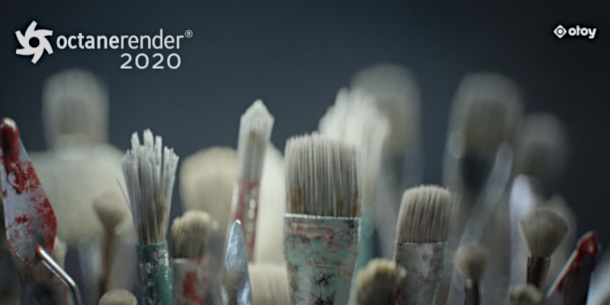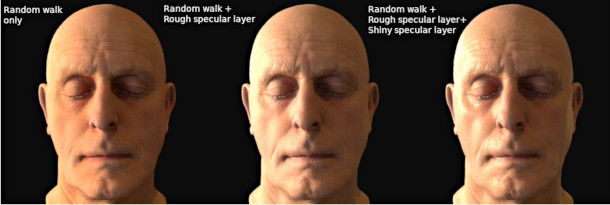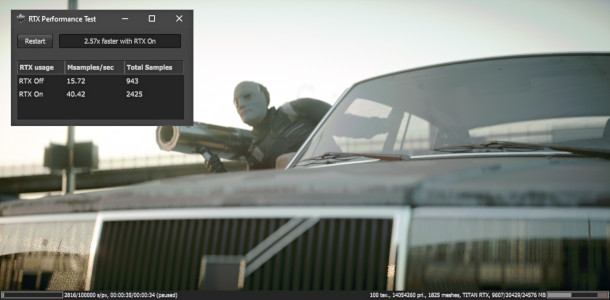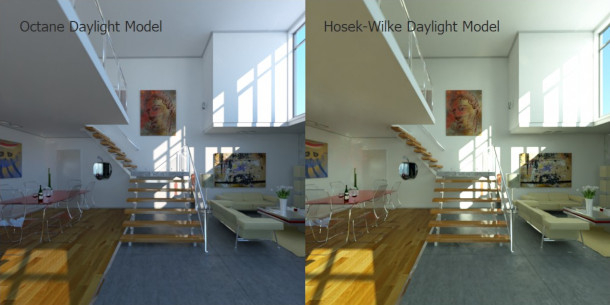Otoy releases OctaneRender 2020.1 in public preview

Otoy has released OctaneRender 2020.1 XB1, the first preview build of the next version of the GPU renderer.
It includes features originally previewed during the 2019 release cycle, like hardware-accelerated ray tracing on Nvidia RTX GPUs, random walk subsurface scattering, and a new spectral hair material.
Entirely new features include a new spectral sky and daylight system, an OpenColorIO-based colour management system, ACES support, and updates to the universal camera and rounded edge shader.
Users of the Cinema 4D plugin will get support for native Cinema 4D noise shaders, while Houdini users will get a new Hydra render delegate, although at the time of posting, neither is publicly available.
In separate news, Otoy has also released a preview of Sculptron: a new GPU-based mesh sculpting tool.

Already previewed in 2019.2: random walk SSS, new spectral hair material and ‘universal dirt’ system
Otoy’s press release for the OctaneRender 2020 public preview is interesting in that a lot of it is about things that aren’t actually new in OctaneRender 2020.1 XB1 itself.
The new features are summarised at the start of the text: the second, and longer, part of the announcement covers features originally rolled out in previous releases.
That includes the major features previewed in OctaneRender 2019.2, including random walk subsurface scattering, a new spectral hair material, a new ‘universal dirt’ system, and updates to volumetric rendering.
As far as we can tell, there have been no major changes to them since the original 2019.2 preview.
Aside from updating the version number, Otoy’s description of those features in its forum post on OctaneRender 2020.1 XB1 hasn’t changed since the corresponding post for OctaneRender 2019.2 XB1.

Updated since 2019.2: RTX acceleration now uses OptiX, not Vulkan
One major feature previewed in OctaneRender 2019.2 that has been updated for 2020.1 is RTX acceleration.
RTX acceleration – that is, rendering accelerated by the new dedicated ray tracing cores in current Nvidia RTX graphics cards – made a big splash when it was first announced in March.
At the time, Otoy cited a speed boost of up to 7.5x via the then-Vulkan-based ray tracing backend.
The implementation has now been switched to Nvidia’s OptiX API, due to “issues affecting VulkanRT [the Vulkan run-time libraries] that still need to be solved by third parties”.
According to Otoy, the change “increases overall render performance for most scenes but specially for complex ones and reduces VRAM usage to almost half to what it was required before”.
Though still significant, the speed boosts cited in the latest announcement are lower than the previous best-case figure: 2-3x for typical scenes, or 2-5x for scenes with “heavy instancing and scattering”.
The current implementation is also limited to triangular geometry: according to a forum post from Otoy, “other geometry types such as particles, hair and … rounded edges are still being rendered in the usual way”.
Scenes that make extensive use of other geometry types “may not see a noticeable improvement” in render times, although Otoy says that support for primitive types will be added in “future releases”.

New in 2020.1: Hosek-Wilkie daylight system, new display colour-management system, ACES support
Entirely new features in OctaneRender 2020.1 include a daylight system based on the Hosek-Wilkie model.
According to Otoy, it produces “more realistic and detailed results than other implementations specially in hazy conditions and near the horizon”.
Other new features include an OpenColorIO-based display colour management system, with the option to import ICC and ICM profiles for monitors; and the option to export ACES OpenEXR files.
The universal camera introduced in OctaneRender 2019.1 has been extended, including new depth of field options, plus support for optical vignetting and split-focus diopter effects.
The rounded edge shader and handling of particle attributes have also been updated: you can find details via the links at the foot of the story.
New in individual plugins: support for native Cinema 4D noise types, Houdini Hydra render delegate
Outside the standalone edition of the renderer, new features due in OctaneRender 2020.1 include support for Cinema 4D’s native noise types, both as 2D textures and to modify 3D volumes.
Houdini users will get a new Hydra render delegate, enabling them to use OctaneRender as a viewport renderer within Solaris, Houdini 18‘s new look dev and shot layout toolset.
At the time of posting, neither is publicly available: according to Otoy, preview releases of the integration plugins for OctaneRender 2020.1, including the Cinema 4D edition, “are a few weeks behind standalone”.
The Hydra delegate is “another project not related directly to the main Houdini plugin” and will be released separately: Otoy hasn’t announced a timescale for the release.
Other previously announced features: Metal support for new Macs “not far off”
One previously announced feature that isn’t part of the initial preview for OctaneRender 2020.1 is support for Apple’s Metal graphics API.
Metal support, which should enable OctaneRender to run on the AMD GPUs in current-gen Macs, was announced earlier this year alongside Apple’s upcoming revamp of its Mac Pro product line.
A new Metal-compatible edition of the software, Octane X, will be available free to buyers of new Mac Pros.
According to Otoy, the release is “not far off”, although the firm hasn’t given an exact date.
Other previously announced features not mentioned in the OctaneRender 2020 documentation include support for polarised light in Spectron, Otoy’s procedural lighting system, and a new ‘anime kernel’.
Updated 11 December 2019: Otoy tells us that it is now “targeting 2020.2” for these features.
New pricing structure
The pricing structure for OctaneRender has also changed, with an ‘Enterprise box licence’ – perpetual licences for the standalone edition and one integration plugin, plus subscription access to the remaining plugins – currently costing €699 for a 12-month subscription and €899 for a 24-month subscription.
Updated 11 December 2019: Otoy tells us that the prices – which include a temporary discount – will be maintained throughout December 2019.
Integration plugins are no longer listed for sale individually in Otoy’s online store, although they are still available on request at their previous prices.
In addition to the commercial versions, some plugins are available free for use on a single GPU via Otoy’s new Prime usage tier.
As well as the existing Blender, UE4 and Unity versions, there is now a new free plugin for DAZ Studio.
Availability and system requirements
OctaneRender 2020.1 XB1 is available as a preview to users with valid product subscriptions.
Otoy hasn’t announced a final release date, but in the past few release cycles, it has taken four to six months to go from an initial XB1 release to a stable build.
The current stable release, OctaneRender 2019.1, is available for 64-bit Windows 7+, Linux and macOS 10.12+. It’s CUDA-based, so you will need a compatible Nvidia GPU.
Read an overview of the features in OctaneRender 2020.1 in Otoy’s press release
(Note: not every feature covered is new in 2020.1)
Read a full list of new features in OctaneRender 2020 XB1 on Otoy’s forum
